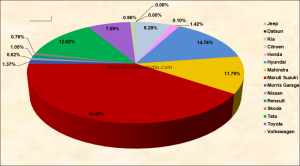Table of Contents
1. Introduction
2. Understanding the Indian Car Buyer
-
- Price Sensitivity
- Fuel Efficiency
- After-Sales Service Importance
- Brand Trust and Recognition
3. Case Studies: Success Stories
-
- Maruti Suzuki: Dominating the Small Car Segment
-
-
- Partnership with Local Player (Maruti Udyog)
- Focus on Affordability and Mileage
- Strong Service Network
-
-
- Hyundai: Rise of the Premium Hatchback
-
-
- Understanding Evolving Customer Preferences
- Feature-Rich Cars with Competitive Pricing
- Building Brand Image through Marketing
-
4. Case Studies: Challenges and Exits
-
- Ford India: Misreading the Market
-
-
- Focus on Premium Sedans in a Budget-Conscious Market
- Lack of Refreshing Popular Models
- After-Sales Service Concerns
-
-
- General Motors: The Tale of Two Exits (1954 & 2017)
-
-
- Initial Failure to Adapt to Local Needs
- Re-entry with Chevrolet, But Limited Success
- High Maintenance Costs and Competition
-
5. Key Learnings and Trends
-
- Importance of Understanding Customer Needs
- Adapting Product Portfolio and Pricing Strategy
- Building a Strong Dealer Network and Service Infrastructure
- The Rise of Domestic Players and New Entrants (e.g., Tata Motors, MG Motors)
6. Conclusion
7. Appendix
8. References (List of sources used for the case study)
- Introduction
India’s automobile market has witnessed meteoric growth. Fuelled by rising incomes, urbanization, and a burgeoning middle class, the demand for personal mobility has skyrocketed.[1] This surge has transformed India into a global automotive hub, attracting both domestic and international players.[2] The industry’s expansion has significantly contributed to the nation’s GDP and employment, making it a vital economic driver.[3]
Case Overview:
This case study explores the strategies, successes, and challenges of various car companies operating in the Indian market. By analyzing specific examples, we aim to understand the factors that contribute to market dominance, the pitfalls of misreading consumer preferences, and the evolving landscape of the Indian automotive industry. This analysis will provide valuable insights for industry stakeholders, policymakers, and researchers.
2. Understanding the Indian Car Buyer
-
- Price Sensitivity
Price sensitivity is a cornerstone of Indian car buying behaviour. Consumers meticulously compare costs, often prioritizing affordability over additional features. Car companies must strike a balance between competitive pricing and offering essential amenities to capture this price-conscious market.
-
- Fuel Efficiency
Fuel efficiency is a paramount consideration for Indian car buyers. Rising fuel prices have accentuated the demand for vehicles that deliver maximum mileage per Litre. Car makers who excel in this area have a significant advantage in the market.
-
- After-Sales Service Importance
After-sales service is a critical factor in the Indian car market.[5] Customers value prompt, efficient, and reliable maintenance and repairs. A strong service network, coupled with skilled technicians and genuine spare parts, significantly influences brand loyalty and customer satisfaction.
-
- Brand Trust and Recognition
Brand trust and recognition play a pivotal role in shaping Indian car buyer preferences. Established brands often enjoy a first-mover advantage, while new entrants must invest heavily in building credibility. A strong brand image assures customers of quality, reliability, and value for money, influencing their purchase decisions.[6]
3. Case Studies: Success Stories
-
- Maruti Suzuki: Dominating the Small Car Segment
-
-
- Partnership with Local Player (Maruti Udyog)
-
Maruti Suzuki has been the undisputed king of the Indian small car segment. A key factor in their success was a strategic partnership with Maruti Udyog, a government-owned company. This collaboration provided Maruti with a strong foothold in the Indian market, allowing them to leverage existing distribution channels and understand local consumer preferences. The partnership proved instrumental in Maruti’s rapid growth and market dominance.
-
-
- Focus on Affordability and Mileage
-
Affordability and mileage have been the core pillars of Maruti Suzuki’s success in the Indian market. By consistently offering vehicles with attractive price points and excellent fuel efficiency, Maruti has catered to the needs of the mass market. Their car models have become synonymous with economy and practicality, making them the preferred choice for first-time car buyers and budget-conscious consumers. This unwavering focus on affordability and mileage has solidified Maruti’s position as a market leader.
-
-
- Strong Service Network
-
A robust service network has been a cornerstone of Maruti Suzuki’s dominance. The company has invested heavily in establishing a vast and efficient service infrastructure across India. This extensive network ensures easy accessibility for customers, leading to higher customer satisfaction. Maruti’s commitment to after-sales service has built strong brand loyalty and has been instrumental in retaining customers even as new competitors enter the market.
-
-
- Hyundai: Rise of the Premium Hatchback
-
Understanding Evolving Customer Preferences
A robust service network has been a key advantage for Maruti Suzuki’s dominance. Maruti has invested heavily in establishing a vast and efficient service infrastructure across India. This extensive network ensures easy accessibility for customers, leading to higher customer satisfaction. Maruti’s commitment to after-sales service has built strong brand loyalty and has been instrumental in retaining customers even as new competitors enter the market.
-
-
- Feature-Rich Cars with Competitive Pricing
-
Hyundai has successfully disrupted the Indian car market by redefining the premium hatchback segment. The brand’s strategy of offering feature-rich cars at competitive prices has resonated well with Indian consumers. Hyundai models have consistently raised the bar in terms of technology, comfort, and safety, while maintaining affordability. This approach has not only attracted first-time car buyers but has also lured customers away from established players in the segment.
-
-
- Building Brand Image through Marketing
-
Hyundai’s success in the Indian market can be attributed to its astute marketing strategies. The company has invested heavily in building a strong brand image focused on modernity, style, and technology. Through effective advertising campaigns, celebrity endorsements, and a strong digital presence, Hyundai has positioned itself as a trendsetter in the automotive industry. This carefully crafted brand image has resonated well with the aspirational Indian consumer, contributing significantly to the company’s growth.
4. Case Studies: Challenges and Exits
-
- Ford India: Misreading the Market
Ford’s exit from the Indian market was a stark reminder of the challenges of operating in a price-sensitive environment. The company’s focus on premium sedans misaligned with the preferences of the average Indian car buyer, who prioritized affordability and fuel efficiency. Ford struggled to compete with established players like Maruti Suzuki and Hyundai, who had a deeper understanding of the market. This misjudgement, coupled with a lack of timely product refreshes, led to declining sales and ultimately, the company’s decision to withdraw from India.
-
-
- Focus on Premium Sedans in a Budget-Conscious Market
-
Ford primarily focused on premium sedans, a segment that caters to a niche audience. In contrast, the Indian car market is predominantly driven by budget-conscious buyers seeking affordable and fuel-efficient options. Ford’s inability to adapt to this prevailing consumer preference resulted in low sales figures and a shrinking market share. The company’s product portfolio failed to resonate with the mass market, leading to its eventual exit from the Indian market.
-
-
- Lack of Refreshing Popular Models
-
Another critical factor in Ford’s downfall in India was the lack of timely updates to its popular models. In a rapidly evolving market, consumers expect regular refreshes with new features and technologies. Ford’s failure to keep pace with this trend led to its products becoming outdated and less appealing to buyers. Competitors, on the other hand, consistently introduced new models and upgrades, capturing the attention of the evolving customer base. This lack of product innovation exacerbated Ford’s challenges in the Indian market.
-
-
- After-Sales Service Concerns
-
Ford India’s challenges were exacerbated by concerns over after-sales service. Customers often reported issues with spare parts availability, long waiting times for service appointments, and inadequate resolution of complaints. A poor service experience can significantly impact brand reputation and customer loyalty.[7] Ford’s inability to address these concerns contributed to a decline in customer satisfaction and sales, ultimately leading to its exit from the Indian market.
-
- General Motors: The Tale of Two Exits (1954 & 2017)
-
-
- Initial Failure to Adapt to Local Needs
-
General Motors’ journey in India has been marked by two failed attempts. The first exit in 1954 was largely attributed to the company’s inability to adapt to the unique needs of the Indian market. GM’s initial offerings were luxury cars, which were ill-suited to the prevailing economic conditions and infrastructure. The company failed to recognize the demand for affordable and durable vehicles, leading to poor sales and ultimately, its withdrawal from the market.
-
-
- Re-entry with Chevrolet, But Limited Success
-
Undeterred by the initial setback, General Motors re-entered the Indian market in 1995 under the Chevrolet brand. However, despite offering a range of products, the company struggled to gain a significant market share. High maintenance costs and a perceived lack of after-sales service compared to competitors hampered Chevrolet’s growth. Additionally, the brand failed to establish a strong connection with Indian consumers, resulting in limited success and ultimately, another exit in 2017.
-
-
- High Maintenance Costs and Competition
-
Chevrolet’s second innings in India was marred by several challenges. A significant factor was the perception of high maintenance costs. Indian consumers are price-sensitive, and the notion of expensive upkeep deterred potential buyers. Moreover, the intense competition from established players like Maruti Suzuki and Hyundai, who had a strong foothold in the market, posed a formidable challenge. Chevrolet struggled to differentiate its offerings and capture a substantial market share, leading to its eventual withdrawal.
5. Key Learnings and Trends
-
- Importance of Understanding Customer Needs
A deep understanding of customer needs is paramount for success in the Indian car market. Companies that have thrived have demonstrated a keen ability to identify and cater to the specific preferences of Indian consumers. This includes factors such as price sensitivity, fuel efficiency, after-sales service, and brand trust. By closely aligning product offerings with consumer desires, companies can build strong brand loyalty and achieve sustained growth.
-
- Adapting Product Portfolio and Pricing Strategy
Successful car companies in India have demonstrated the ability to adapt their product portfolios and pricing strategies to changing market dynamics. Offering a mix of affordable entry-level models and aspirational premium cars has been a winning formula. Moreover, flexible pricing strategies, including discounts, offers, and financing options, have helped companies to reach a wider customer base. Continuously evolving product lines to meet evolving consumer preferences is crucial for long-term success.
-
- Building a Strong Dealer Network and Service Infrastructure
A robust dealer network and efficient service infrastructure are essential for capturing and retaining customers in India. Companies that have invested in expanding their reach and providing exceptional after-sales support have gained a competitive edge. A strong dealer network ensures easy accessibility for customers, while a well-equipped service infrastructure builds trust and loyalty. A seamless ownership experience, from purchase to service, is crucial for long-term success.
-
- The Rise of Domestic Players and New Entrants (e.g., Tata Motors, MG Motors)
The Indian automotive landscape is witnessing a resurgence of domestic players and a wave of new entrants. Companies like Tata Motors have successfully transformed their image and product offerings to compete effectively. Their focus on innovation, safety, and design has resonated with consumers. Similarly, new entrants like MG Motors have disrupted the market with their stylish and smart features-packed vehicles. This increased competition has led to a more dynamic and customer-centric market, benefiting consumers with a wider choice of products and services.
6. Conclusion:
The Indian car market is a dynamic and complex arena, characterized by fierce competition, evolving consumer preferences, and technological advancements. Success in this market requires a deep understanding of customer needs, agility in adapting to market trends, and a strong focus on after-sales service. The rise of domestic players and new entrants is intensifying competition, forcing established brands to innovate and elevate their offerings. As the market matures, factors like electrification, connectivity, and autonomous driving will shape the future of the Indian automotive industry. Companies that can effectively combine innovation with customer centricity will emerge as leaders in this ever-changing landscape.
7. Appendix
Indian Car Manufacturers’ Market Share – June 2024

Indian Car Manufacturers’ Market Share – June 2024

- References (List of sources used for the case study)
-
- The future of mobility in India’s passenger-vehicle market : Published on : July 18, 2018 : Retrieved on July 29, 2024
- India set to transform into a global automotive hub : Published on : October 10, 2023 : Retrieved on July 29, 2024
- Rise Of The Automobile Sector In India : Retrieved on July 29, 2024
- What Is a Case Study and Why You Should Use Them : Retrieved on July 29, 2024
- Key Takeaways from Top Leaders at India Vehicle After Sales Summit 2021 : Published on : December 23, 2021 : Retrieved on July 29, 2024
- How Brand Image Impacts Purchasing Decisions? : Retrieved on July 29, 2024
- The Impact of Poor Customer Service Repeats on Brands Worldwide : Published on June 15 2023 : Retrieved on July 29, 2024
For more detailed insights, strategic recommendations, or to conduct a similar in-depth market study, please contact info@maction.com. With expertise in tailored research solutions, Maction Consulting provides the insights needed to make data-driven decisions that elevate brand performance in the marketplace.





